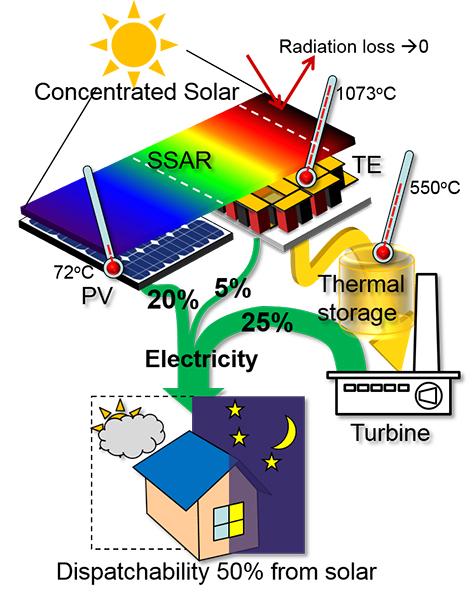Hybrid Solar-Energy Harvester Aims for 50% Efficiency 26770
A research team from Purdue University has created a hybrid system that harvests light and heat from the sun and uses steam to create energy.
September 8, 2016
Solar-energy researchers are eyeing a number of key ways to bolster the efficiency of current solar cells, one of which to harvest energy not only from sunlight but also the heat emanated from the sun.
New research in this effort is from Purdue University, where researchers have developed a concept for a hybrid system they said has the potential to reach 50% energy efficiency. The system combines two different ways to harvest energy from sunlight and another way to generate that energy into electricity, and also stores the energy for future use.
“For many years, there has been a debate about photovoltaic flat panels versus concentrating solar power, since both have certain virtues and disadvantages,” Peter Bermel, an assistant professor in Purdue University's School of Electrical and Computer Engineering, told Design News. “To us, it made sense to combine them, to benefit from the best of both worlds.”

This schematic depicts a new concept from researchers at Purdue University that they said could bring highly efficient solar power by combining three types of technologies that convert different parts of the light spectrum and also store energy for use after sundown. (Source: Purdue University/Peter Bermel)
The hybrid system uses solar photovoltaic cells that convert visible and ultraviolet light into electricity; thermoelectric devices that convert heat into electricity; and steam turbines that generate electricity, he said.
More specifically, the technology works by using a selective solar absorbing-reflector to split the solar spectrum into photovoltaic and thermal parts of the spectrum, and rejecting long wavelengths of sunlight to maximize the efficiency, Bermel explained.
“It then feeds each component with the corresponding parts of the spectrum,” he said. “This is much more efficient than using either option in a standalone form factor.” The thermoelectric devices and steam turbines would be driven by heat collected and stored using mirrors to focus sunlight onto the selective solar absorber and reflector.
Indeed, the selective solar absorber and reflector -- which was technically challenging for the team to develop -- is the lynchpin of this approach, Bermel said. It plays two key roles in the system -- to increase efficiency by reflecting visible light but absorbing near-infrared photons, and to increase the temperature of the stored heat, which is then harnessed as electricity when it is needed throughout the course of the day.
READ MORE ARTICLES ON SOLAR ENERGY:
The team still needs a small-scale prototype system to test its hybrid energy harvester, which at this point is theoretical. Bermel said researchers are in the process of applying for grants to continue its research, which will be published in a future issue of the journal, Energy & Environmental Science.
However, Bermel maintains that the approach will be up to 50% efficient, in contrast to commercial crystalline silicon photovoltaic modules on the market today that currently have a ceiling of 24.1% efficiency. “There are also triple-junction cells on the market with higher efficiencies as well, but they are roughly 100 times more expensive, and designed only for specialized applications, such as satellite power,” he added.
The US Department of Energy supported the work through the Bay Area Photovoltaic Consortium. The National Science Foundation also backed Bermel and his team.
Elizabeth Montalbano is a freelance writer who has written about technology and culture for more than 15 years. She has lived and worked as a professional journalist in Phoenix, San Francisco, and New York City. In her free time she enjoys surfing, traveling, music, yoga, and cooking. She currently resides in a village on the southwest coast of Portugal.
About the Author(s)
You May Also Like



